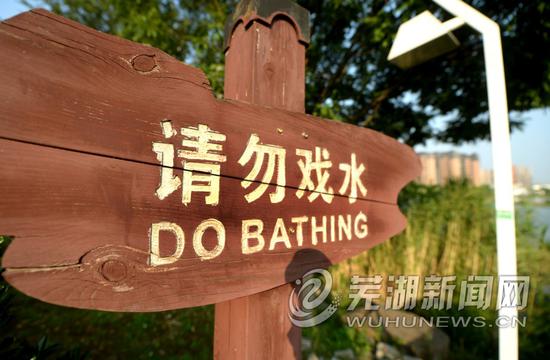No paddling
« previous post | next post »
And no dabbling either (see "Selected readings").
Qǐng wù xī shuǐ
請勿嬉水
"Please don't play in the water"
The anonymous contributor who took this photograph in Hong Kong and sent it to me remarked: "I believe it is correct English though."
You will also see signs that translate xī shuǐ 嬉水 ("play in the water") as ("frolicking")
The sinoglyphic form as typed above yields 6,240 ghits.
Typed thus, it yields 105,000 ghits:
Qǐng wù xì shuǐ
請勿戲水
"Please don't play in the water"
For a double whammy of a Chinglish bonus, behold this nonnegative wonder:
Wonders never cease.
Selected readings
- "No dabble" (10/19/11)
- "Take Care To Fall Into Water" (1/23/19)
- "Slip carefully " (5/6/14) — a Chinglish classic with many variations


AntC said,
May 3, 2023 @ 12:13 am
"I believe it is correct English though."
Yes, I could believe it is correct English — if only there was a bit more context, like a picture of the body of water it's referring to.
Perhaps it's a shallow pond (ornamental with lilies, lotus flowers, goldfish?) or broad drainage channel/canalised stream? Then it's not deep enough to swim in, but would be tempting to kids as a paddling pool. For example, in Kowloon Park up the back of Tsim Sha Tsui, there's both a public swimming pool/kids paddling pool at the northern edge and a 'Bird Lake' and ornamental lake amongst parterres in the central/south. I'd guess there are 'no paddling' signs at the latter, although nobody's translated the signs for the birds — which will paddle anywhere. (Different sense of 'paddle'.)
The activity behind the red ban sign maybe has picked up a yet another sense of 'paddle': to paddle a boat/canoe.
(In general in Hong Kong, I would avoid contact with standing water: it's probably full of pollutants. Hong Kongers even avoid the sea, for the same reason. I was treated as a crazy gweilo when I went for a paddle at 'Big Wave Beach'/'Shek O Park' even though it's well away from built-up areas.)
Josh said,
May 3, 2023 @ 12:58 am
Yes, this does seem like correct UK English, in which the verb “paddle” corresponds to the US English “wade.”
https://dictionary.cambridge.org/us/dictionary/english/paddle
Stephen Jones said,
May 3, 2023 @ 1:27 am
Cf. “gamboling” 嬉戏, discouraged in elevator…
https://stephenjones.blog/2018/07/01/silly-signs/
Lynne Murphy said,
May 3, 2023 @ 2:44 am
It's straightforward British English. American English would often use 'wading' in the context, but it's not a straightforward translation. I've included it in one of my transatlantic 'Untranslatables' lists (with all the usual caveats about the term 'untranslatable':
https://separatedbyacommonlanguage.blogspot.com/2016/11/untranslatables-vi-summary.html
Taylor, Philip said,
May 3, 2023 @ 4:52 am
The cartoon character in the barred red circle appears to be wearing a black wet suit, possibly accompanied by a welder's helmet, neither of which do I associate with the concept of paddling. For me, a Briton with almost zero exposure to the American topolect, "paddling" involves walking in water with at most one's ankles or perhaps a little more covered, and requires almost zero effort, while "wading" involves walking in water nearly up to one's knees or even higher, and requires not-inconsiderable effort since one is displacing a considerably greater volume of water than one does when paddling. The effort required to wade is captured in such metaphors as "to wade in with both fists", etc.
Victor Mair said,
May 3, 2023 @ 5:08 am
The scene depicted shows significant wave action and splashing. The dynamic posture of the person indicates that he / she / they / it is making a not inconsiderable effort to plow forward through the water, which — as is its wont — is resisting his progress.
Daniel Barkalow said,
May 3, 2023 @ 10:56 am
The placement of the red line led me to interpret the image as a person spraying some liquid from a canister with a hose.
David said,
May 3, 2023 @ 11:57 am
I thought of dog-paddling, where the hands (front paws) do the paddling. If the British usage refers to wading in ankle-deep water, it must be referring to the feet (back paws).
mark hansell said,
May 3, 2023 @ 1:37 pm
I interpreted it as "no splashing", that is, no splashing people with water to annoy them, as people do in swimming pools. But as mentioned above, very hard to know without context.
KeithB said,
May 4, 2023 @ 8:59 am
Well, at least Mr. Icon seems to be having a good time.
David Scott Deden said,
May 5, 2023 @ 11:10 pm
I thought the picture referred to a cheerful miner, so 'no paddling' made absolutely no sense to me.